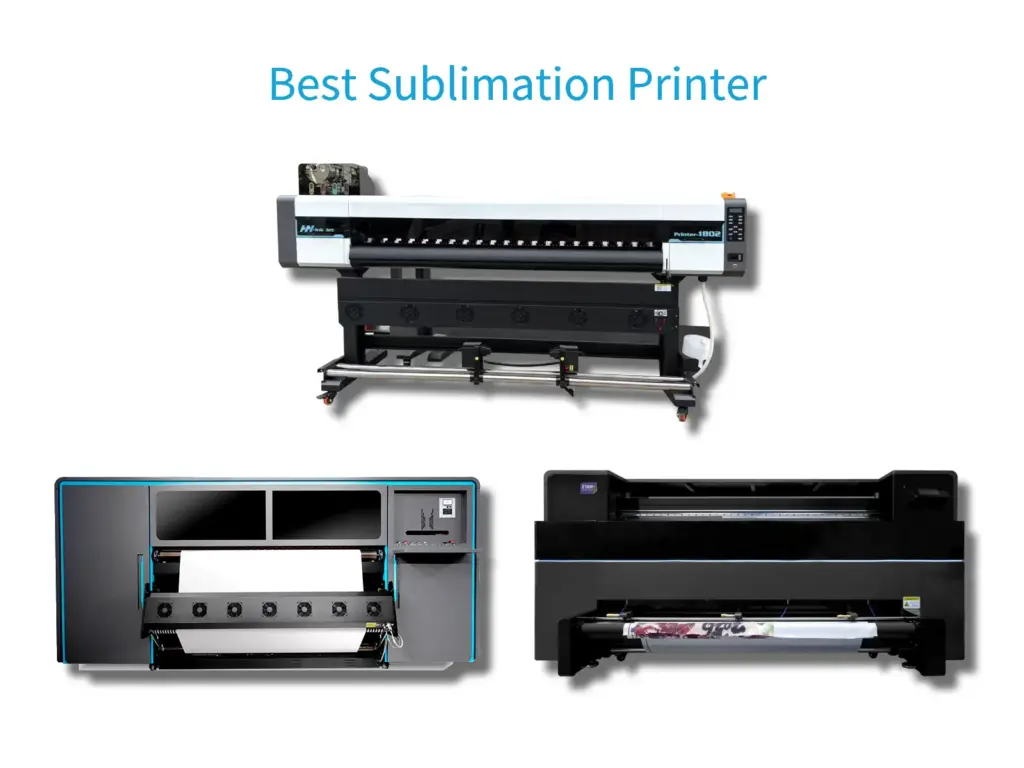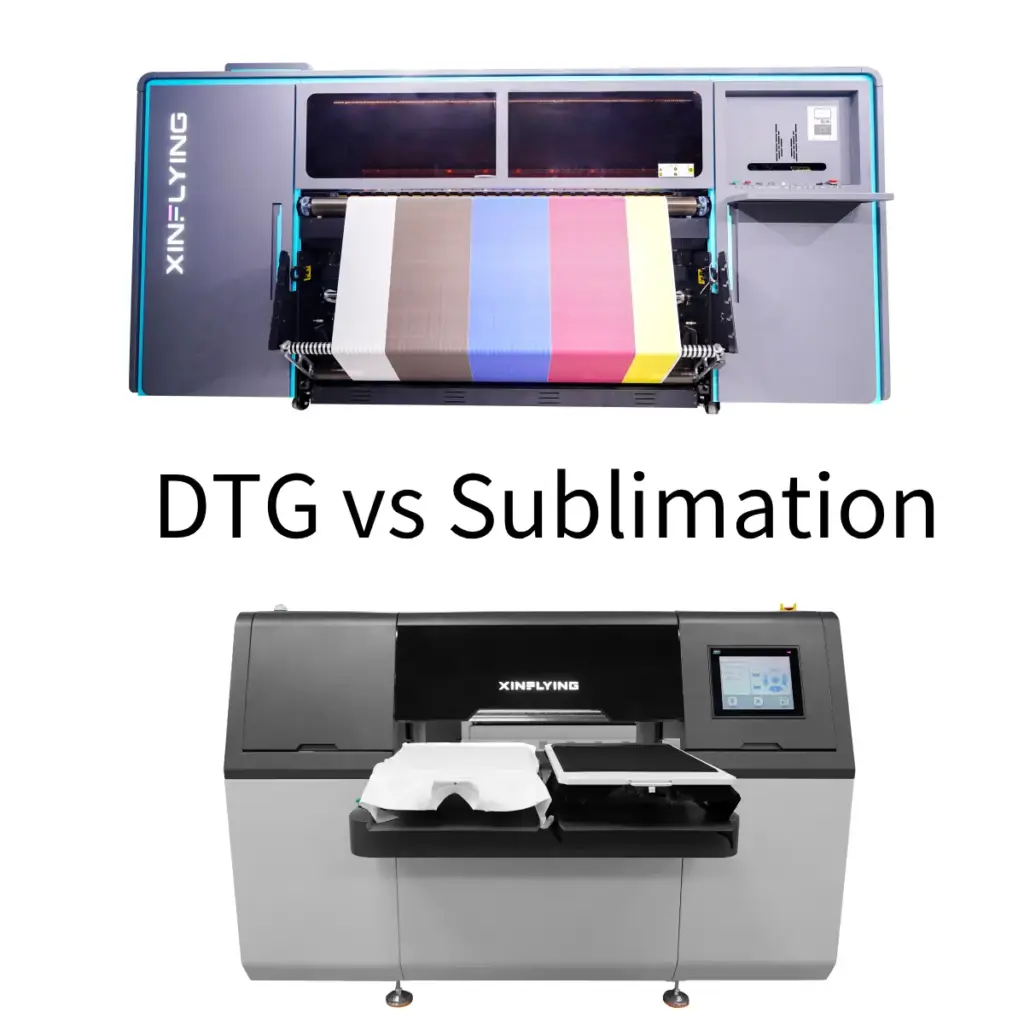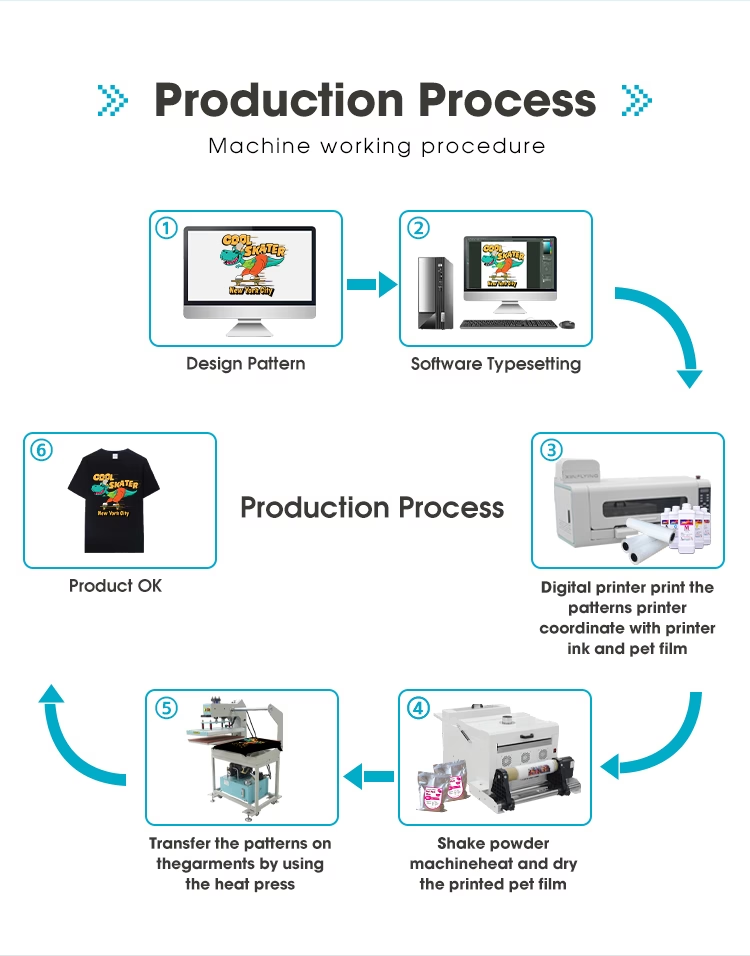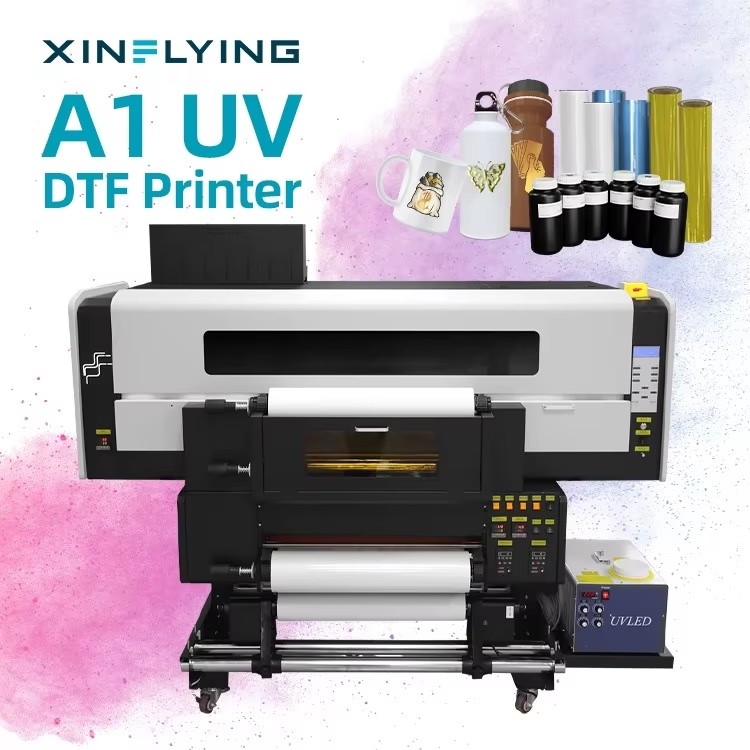Η τεχνολογία εκτύπωσης έχει προχωρήσει πολύ, προσφέροντας διάφορες μεθόδους για να ζωντανέψουν εικόνες σε διαφορετικές επιφάνειες. Δύο δημοφιλείς τεχνικές εκτύπωσης στη βιομηχανία σήμερα είναι η εκτύπωση UV DTF και η εκτύπωση DTF. Ενώ και οι δύο μέθοδοι προσφέρουν εντυπωσιακά αποτελέσματα, έχουν ξεχωριστά χαρακτηριστικά που τα ξεχωρίζουν. Σε αυτό το άρθρο, θα εμβαθύνουμε στις λεπτομέρειες κάθε μεθόδου εκτύπωσης, συγκρίνετε τα δυνατά και τα όριά τους, και παρέχετε καθοδήγηση σχετικά με την επιλογή της σωστής μεθόδου εκτύπωσης για τις ανάγκες σας.
Τι είναι η εκτύπωση UV DTF?
Εκτύπωση UV DTF, συντομογραφία για εκτύπωση Ultraviolet Direct to Film, είναι μια τεχνολογία αιχμής που επιτρέπει τη μεταφορά εικόνας υψηλής ποιότητας σε διάφορα υποστρώματα. Σε αντίθεση με τις παραδοσιακές μεθόδους εκτύπωσης, Εκτύπωση UV DTF χρησιμοποιεί υπεριώδη ακτινοβολία (UV) μελάνια που ωριμάζουν με υπεριώδη ακτινοβολία για εξαιρετική αντοχή και ζωντανά χρώματα.
Πώς να χρησιμοποιήσετε τον εκτυπωτή UV DTF?
Βήμα 1: Σχεδιασμός στο λογισμικό RIP
Πρώτα, προετοιμάστε το έργο τέχνης με λογισμικό RIP στον υπολογιστή. Στη συνέχεια, τοποθετήστε το φιλμ UV DTF A στην πλατφόρμα του εκτυπωτή UV DTF.
Βήμα 2: Εκτύπωση σε ταινία
Προγεμίστε το δοχείο με μελάνι CMYK, λευκό μελάνι, και βερνίκι για να εκτυπώσετε το σχέδιό σας στην ταινία UV DTF.
Βήμα 3: Πολυστρωματική ταινία Β
Τοποθετήστε την εκτυπωμένη μεμβράνη Α στη μηχανή πλαστικοποίησης για να την κολλήσετε με την ταινία Β.
Βήμα 4: Τοποθετήστε ταινία στα Προϊόντα
Ξεφλουδίστε το φιλμ του μοτίβου και κολλήστε το στο αντικείμενο που θέλετε να εκτυπώσετε. Στη συνέχεια, σιγά -σιγά ξεφλουδίστε την ταινία Β, και το προϊόν σας έχει τελειώσει.
Πλεονεκτήματα και μειονεκτήματα της εκτύπωσης UV DTF

Πλεονεκτήματα της εκτύπωσης UV DTF
- Υψηλή ποιότητα και ευκρίνεια εικόνας
Η εκτύπωση UV DTF προσφέρει εξαιρετική ποιότητα εικόνας με ευκρινείς λεπτομέρειες και ζωντανά χρώματα. Τα μελάνια UV έχουν μεγάλη χρωματική γκάμα, επιτρέποντας την ακριβή αναπαραγωγή χρώματος.
- Ευρεία χρωματική γκάμα
Η εκτύπωση UV DTF επιτρέπει την εκτύπωση μεγάλης γκάμα χρωμάτων σε διάφορα υποστρώματα, με αποτέλεσμα πλούσια και ζωντανά σχέδια.
- Γρήγορος χρόνος παραγωγής
Σε σύγκριση με τις παραδοσιακές μεθόδους εκτύπωσης, Η εκτύπωση UV DTF προσφέρει ταχύτερους χρόνους παραγωγής. Τα μελάνια UV στεγνώνουν σχεδόν αμέσως, εξαλείφοντας την ανάγκη για εκτεταμένες περιόδους στεγνώματος.
- Δυνατότητα εκτύπωσης σε διάφορα υποστρώματα
Η εκτύπωση UV DTF παρέχει την ευελιξία για εκτύπωση σε μεγάλη γκάμα υλικών, συμπεριλαμβανομένων των υφασμάτων, πλαστικά είδη, ποτήρι, κι αλλα. Αυτή η ευελιξία το καθιστά ιδανική επιλογή για επιχειρήσεις που θέλουν να διαφοροποιήσουν τις προσφορές των προϊόντων τους.
Περιορισμοί της εκτύπωσης UV DTF
- Κόστος μελανιών και εξοπλισμού UV
Η εκτύπωση UV DTF απαιτεί εξειδικευμένα μελάνια και εξοπλισμό UV, το οποίο μπορεί να είναι πιο ακριβό σε σύγκριση με τα παραδοσιακά υλικά εκτύπωσης. Επιπροσθέτως, Τα μελάνια UV μπορεί να έχουν μικρότερη διάρκεια ζωής, απαιτούν συχνές αντικαταστάσεις.
- Περιορισμένη ευελιξία με ορισμένα υλικά
Ενώ η εκτύπωση UV DTF μπορεί να εφαρμοστεί σε διάφορα υποστρώματα, ορισμένα υλικά μπορεί να μην είναι κατάλληλα λόγω της υφής ή της σύνθεσης της επιφάνειας τους. Είναι σημαντικό να δοκιμάσετε την εκτύπωση σε διαφορετικά υλικά πριν δεσμευτείτε για παραγωγή μεγάλης κλίμακας.
- Απαιτήσεις συντήρησης και συντήρησης
Ο εξοπλισμός εκτύπωσης UV DTF απαιτεί τακτική συντήρηση και συντήρηση για να διασφαλιστεί η σταθερή απόδοση. Αυτό περιλαμβάνει τον καθαρισμό των κεφαλών του εκτυπωτή και τη διασφάλιση βέλτιστων συνθηκών για σκλήρυνση με υπεριώδη ακτινοβολία.
Τι είναι η εκτύπωση DTF?
Εκτύπωση DTF, ή Απευθείας στην εκτύπωση φιλμ, είναι μια τεχνική που περιλαμβάνει την εκτύπωση σχεδίων σε μια μεμβράνη χρησιμοποιώντας εξειδικευμένα μελάνια, τα οποία αργότερα μεταφέρονται στο επιθυμητό υπόστρωμα.
Πώς να χρησιμοποιήσετε τον εκτυπωτή DTF?
Βήμα 1: Σχεδιασμός στο λογισμικό RIP
Παρόμοια με την εκτύπωση UV DTF, σχεδιάστε το έργο τέχνης χρησιμοποιώντας λογισμικό γραφιστικής, διασφαλίζοντας την επίτευξη του επιθυμητού σχεδίου και ποιότητας εικόνας.
Βήμα 2: Εκτύπωση στην ταινία PET
Τοποθετήστε το φιλμ PET στο Εκτυπωτής DTF δίσκους και ξεκινήστε την εκτύπωση. Στη συνέχεια, το σχέδιο σχεδίασης θα μεταφερθεί σε αυτό.
Βήμα 3: Bond Ink with Powder
Με μηχανή ανακίνησης πούδρας, ο Συγκολλητική σκόνη DTF μπορεί να απλωθεί ομοιόμορφα στο φιλμ PET και να στεγνώσει τα γραφικά.
Βήμα 4: Μοτίβο μεταφοράς σε κλωστοϋφαντουργικά προϊόντα
Τοποθετήστε τη μεμβράνη DTF PET στο πάνω μέρος του υποστρώματος και μεταφέρετε το σχέδιο χρησιμοποιώντας μηχανή θερμικής πρέσας.
Πλεονεκτήματα και μειονεκτήματα της εκτύπωσης DTF
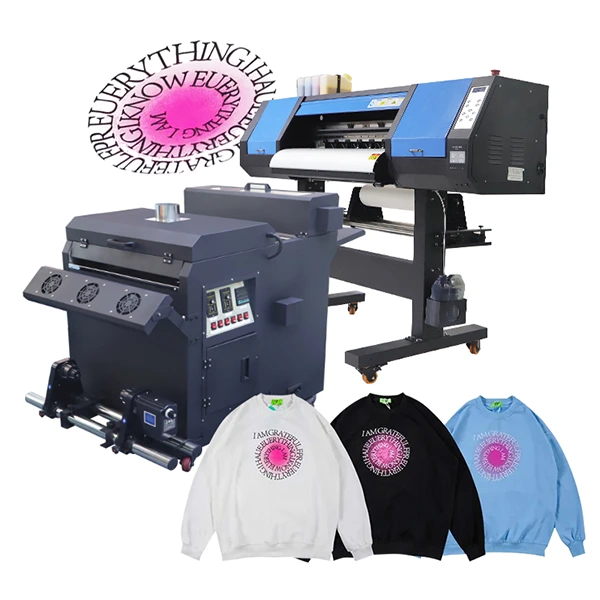
Πλεονεκτήματα της εκτύπωσης DTF
- Οικονομική μέθοδος εκτύπωσης
Η εκτύπωση DTF θεωρείται οικονομικά αποδοτική, κυρίως λόγω του χαμηλότερου κόστους εξοπλισμού και μελάνης σε σύγκριση με την εκτύπωση UV DTF. Αυτό το καθιστά προσιτό σε μικρές επιχειρήσεις και ιδιώτες που επιθυμούν να εμπλακούν στον κλάδο της εκτύπωσης.
- Ευελιξία όσον αφορά τα συμβατά υποστρώματα
Όπως η εκτύπωση UV DTF, Η εκτύπωση DTF επιτρέπει την εκτύπωση σε διάφορα υποστρώματα, συμπεριλαμβανομένων των υφασμάτων, κεραμικά, πλαστικά είδη, κι αλλα. Αυτή η ευελιξία επεκτείνει τη γκάμα των προϊόντων που μπορούν να παραχθούν χρησιμοποιώντας εκτύπωση DTF.
- Δυνατότητα επίτευξης ζωντανών χρωμάτων και λεπτών λεπτομερειών
Η εκτύπωση DTF μπορεί να επιτύχει ζωντανά και ζωντανά χρώματα, καθώς και λεπτές λεπτομέρειες, καθιστώντας το κατάλληλο για περίπλοκα σχέδια και πολύπλοκα έργα τέχνης.
- Εύκολο στη χρήση και στον καθαρισμό
Οι εκτυπωτές DTF είναι φιλικοί προς το χρήστη, απαιτούν ελάχιστη εγκατάσταση και συντήρηση. Επιπροσθέτως, η διαδικασία καθαρισμού είναι σχετικά απλή, επιτρέποντας ομαλότερη λειτουργία και μειωμένο χρόνο διακοπής λειτουργίας.
Περιορισμοί της εκτύπωσης DTF
- Περιορισμένη χρωματική γκάμα σε σύγκριση με το UV DTF
Ενώ η εκτύπωση DTF μπορεί να επιτύχει ζωντανά χρώματα, Η χρωματική του γκάμα μπορεί να είναι στενότερη σε σύγκριση με την υπεριώδη DTF, περιορίζοντας το εύρος των αποχρώσεων και των τόνων που μπορούν να αναπαραχθούν.
- Μεγαλύτερος χρόνος παραγωγής
Η εκτύπωση DTF ενδέχεται να απαιτεί πρόσθετα βήματα για τη μεταφορά του σχεδίου στο υπόστρωμα, που μπορεί να οδηγήσει σε μεγαλύτερους χρόνους παραγωγής σε σύγκριση με την εκτύπωση UV DTF.
- Μπορεί να απαιτούνται πρόσθετα βήματα για ορισμένα υφάσματα
Ορισμένα υφάσματα ενδέχεται να απαιτούν διαδικασίες προεπεξεργασίας πριν από την εκτύπωση Μελάνες DTF. Αυτό μπορεί να προσθέσει πολυπλοκότητα και χρόνο στη συνολική διαδικασία εκτύπωσης.
UV DTF vs DTF: Μια Σύγκριση
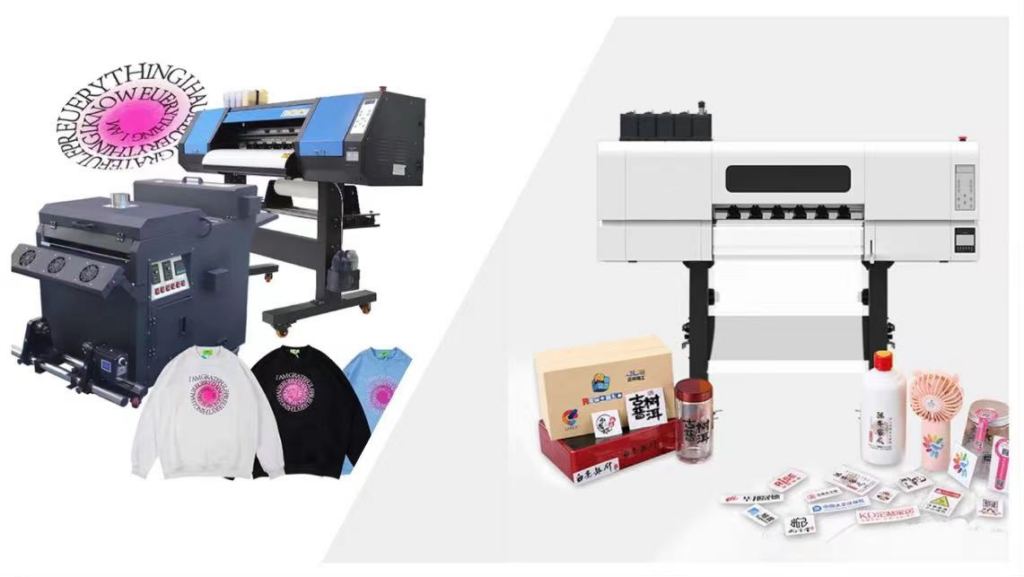
ΕΝΑ. Σύγκριση ποιότητας εκτύπωσης
Ευκρίνεια και ευκρίνεια
Τόσο η UV DTF όσο και η εκτύπωση DTF μπορούν να επιτύχουν εκτυπώσεις υψηλής ανάλυσης με ευκρινείς λεπτομέρειες. Ωστόσο, Η εκτύπωση UV DTF μπορεί να προσφέρει ελαφρώς πιο ευκρινή αποτελέσματα λόγω της διαδικασίας σκλήρυνσης με υπεριώδη ακτινοβολία, που ενισχύει τη μονιμότητα του μελανιού.
Ακρίβεια χρώματος και ζωντάνια
Η εκτύπωση UV DTF προσφέρει γενικά μια ευρύτερη χρωματική γκάμα, επιτρέποντας πιο ακριβή αναπαραγωγή χρωμάτων και ζωντανά σχέδια. Εκτύπωση DTF, ενώ είναι ικανό για ζωηρά χρώματα, μπορεί να έχει περιορισμούς στην επίτευξη συγκεκριμένων αποχρώσεων και τόνων.
σι. Τύποι Υποστρωμάτων
Επιλογές υφασμάτων
Τόσο η UV DTF όσο και η εκτύπωση DTF μπορούν να χρησιμοποιηθούν για εκτύπωση σε διάφορους τύπους υφασμάτων, συμπεριλαμβανομένου του βαμβακιού, πολυεστέρας, και αναμειγνύεται. Ωστόσο, Η εκτύπωση DTF μπορεί να απαιτεί πρόσθετα βήματα ή προεπεξεργασία για ορισμένα υφάσματα για να διασφαλιστεί η βέλτιστη πρόσφυση του μελανιού.
Εκτύπωση σε σκληρές επιφάνειες
Όταν πρόκειται για εκτύπωση σε σκληρές επιφάνειες όπως γυαλί, πλαστική ύλη, ή κεραμικά, Η εκτύπωση UV DTF είναι η προτιμώμενη επιλογή. Η διαδικασία σκλήρυνσης με υπεριώδη ακτινοβολία εξασφαλίζει εξαιρετική πρόσφυση και ανθεκτικότητα μελανιού σε αυτές τις επιφάνειες.
ντο. Ταχύτητα και Αποδοτικότητα Παραγωγής
Η εκτύπωση UV DTF προσφέρει ταχύτερους χρόνους παραγωγής σε σύγκριση με την εκτύπωση DTF. Το στιγμιαίο στέγνωμα των μελανιών UV DTF εξαλείφει την ανάγκη για εκτεταμένες περιόδους στεγνώματος, επιτρέποντας πιο αποτελεσματική ροή εργασίας.
ρε. Σύγκριση Κόστους
Η εκτύπωση UV DTF έχει γενικά υψηλότερο κόστος εκ των προτέρων λόγω των εξειδικευμένων μελανιών και εξοπλισμού UV που απαιτούνται. Εκτύπωση DTF, από την άλλη, προσφέρει ένα πιο οικονομικό σημείο εισόδου για όσους ξεκινούν τη δουλειά τους
εκτυπωτικά εγχειρήματα.
μι. Απαιτήσεις συντήρησης και συντήρησης
Τόσο ο εξοπλισμός εκτύπωσης UV DTF όσο και ο εξοπλισμός εκτύπωσης DTF απαιτούν τακτική συντήρηση και συντήρηση. Ωστόσο, Οι εκτυπωτές UV DTF ενδέχεται να απαιτούν συχνότερους καθαρισμούς και αντικαταστάσεις μελανιών λόγω της φύσης των μελανιών UV.
DTF εναντίον UV DTF, Ποιο είναι Καλύτερο?
| Τύπος | Εκτύπωση DTF | Εκτύπωση UV DTF |
| Τεχνολογία | Εκτυπώνει σε μια μεμβράνη που στη συνέχεια πιέζεται θερμικά πάνω στο υλικό. | Συνδυάζει την τεχνολογία DTF με το φως UV για να σκληρύνει άμεσα το μελάνι. |
| Μελάνι | Χρησιμοποιεί λευκό μελάνι CMYK+, τυπωμένο σε διαφανές φιλμ PET. | Χρησιμοποιεί μελάνι UV, τυπωμένο σε διαφανές φιλμ PET. |
| Εφαρμογή | Βαμβάκι, πολυεστέρας, μείγματα βαμβακιού-πολυ, δέρμα, νάιλον, κι αλλα. | Βαμβάκι, πολυεστέρας, μείγματα βαμβακιού-πολυ, δέρμα, νάιλον, πλαστική ύλη, ξύλο, μέταλλο, ακόμα και γυαλί, κι αλλα. |
| Λεπτομέρεια | Πολύ υψηλή ποιότητα εικόνας και λεπτομέρεια. | Υψηλή ποιότητα εικόνας και λεπτομέρεια, αν και η διαδικασία UV μπορεί να την επηρεάσει ελαφρώς. |
| Αντοχή | Εξαιρετικά ανθεκτικό, αλλά μπορεί να μην διαρκέσει όσο το UV DTF. | Εξαιρετικά ανθεκτικό, Η διαδικασία UV επεκτείνει τη μακροζωία εκτύπωσης. |
Πίνακας σύγκρισης DTF έναντι UV DTF
Πότε να επιλέξετε εκτύπωση UV DTF
Η εκτύπωση UV DTF είναι μια κατάλληλη επιλογή για επιχειρήσεις ή ιδιώτες που αναζητούν εκτυπώσεις υψηλής ποιότητας με ζωηρά χρώματα και ευκρινείς λεπτομέρειες. Είναι ιδανικό για όσους δίνουν προτεραιότητα σε ταχύτερους χρόνους παραγωγής, έχουν ανάγκη για εκτύπωση σε σκληρές επιφάνειες, και μπορεί να καλύψει το αρχικό υψηλότερο κόστος.
Πότε να επιλέξετε την εκτύπωση DTF
Η εκτύπωση DTF είναι μια οικονομικά αποδοτική επιλογή για όσους ξεκινούν στον κλάδο της εκτύπωσης. Προσφέρει ευελιξία όσον αφορά τα συμβατά υποστρώματα και είναι σχετικά εύκολο στη χρήση και τη συντήρηση. Η εκτύπωση DTF συνιστάται για όσους δίνουν προτεραιότητα στην αποδοτικότητα του κόστους, ευελιξία στα υλικά εκτύπωσης, και απλότητα στη λειτουργία.
Επιλογή της σωστής μεθόδου εκτύπωσης

Επιθυμητή ποιότητα εκτύπωσης
Λάβετε υπόψη το επίπεδο ευκρίνειας της εικόνας, ακρίβεια χρώματος, και ζωντάνια που απαιτείται για τις εκτυπώσεις σας. Η εκτύπωση UV DTF υπερέχει σε αυτούς τους τομείς, ενώ η εκτύπωση DTF προσφέρει μια πιο οικονομική επιλογή με αξιοσέβαστη ποιότητα εκτύπωσης.
Τύπος Υλικών που θα Εκτυπωθούν
Λάβετε υπόψη την ποικιλία των υποστρωμάτων στα οποία σκοπεύετε να εκτυπώσετε. Εάν αναμένετε την ανάγκη για εκτύπωση σε σκληρές επιφάνειες ή υλικά που μπορεί να απαιτούν προεπεξεργασία, Η εκτύπωση UV DTF είναι η καλύτερη επιλογή.
Ποσότητες και προθεσμίες παραγωγής
Εάν έχετε αυστηρές προθεσμίες παραγωγής ή απαιτήσεις εκτύπωσης μεγάλου όγκου, Ο γρήγορος χρόνος παραγωγής της εκτύπωσης UV DTF μπορεί να είναι πιο κατάλληλος. Ωστόσο, εάν οι ποσότητες παραγωγής δεν αποτελούν πρωταρχικό μέλημα, Η εκτύπωση DTF προσφέρει μια ικανή εναλλακτική λύση.
Διαθέσιμος προϋπολογισμός
Εξετάστε τον διαθέσιμο προϋπολογισμό σας για εξοπλισμό, μελάνια, και συντήρηση. Η εκτύπωση UV DTF απαιτεί γενικά υψηλότερη αρχική επένδυση, ενώ η εκτύπωση DTF παρουσιάζει ένα πιο οικονομικό σημείο εισόδου. Επίσης, είναι σημαντικό να επιλέξετε α αξιόπιστος κατασκευαστής υφασμάτινων εκτυπωτών.
συμπέρασμα
Συμπερασματικά, Η εκτύπωση UV DTF και η εκτύπωση DTF είναι δύο διαφορετικές μέθοδοι που προσφέρουν εξαιρετική ποιότητα εικόνας και ευελιξία.
Η εκτύπωση UV DTF υπερέχει όσον αφορά τα ζωντανά χρώματα, αιχμηρές λεπτομέρειες, και δυνατότητα εκτύπωσης σε διάφορα υποστρώματα, καθιστώντας το ιδανικό για επιχειρήσεις με υψηλότερους προϋπολογισμούς και συγκεκριμένες ανάγκες εκτύπωσης. Εκτύπωση DTF, από την άλλη, παρέχει ένα οικονομικό σημείο εισόδου για τις μικρές επιχειρήσεις και τα άτομα που αναζητούν ευελιξία, απλότητα, και ευκολία χρήσης.
Τελικά, η επιλογή μεταξύ της εκτύπωσης UV DTF και της εκτύπωσης DTF εξαρτάται από παράγοντες όπως οι απαιτήσεις εκτύπωσης, ποικιλομορφία υποστρώματος, ποσότητες παραγωγής, και διαθέσιμο προϋπολογισμό. Λαμβάνοντας υπόψη αυτούς τους παράγοντες και κατανοώντας τα δυνατά σημεία και τους περιορισμούς κάθε μεθόδου, μπορείτε να πάρετε μια τεκμηριωμένη απόφαση και να επιτύχετε εξαιρετικά αποτελέσματα εκτύπωσης.

